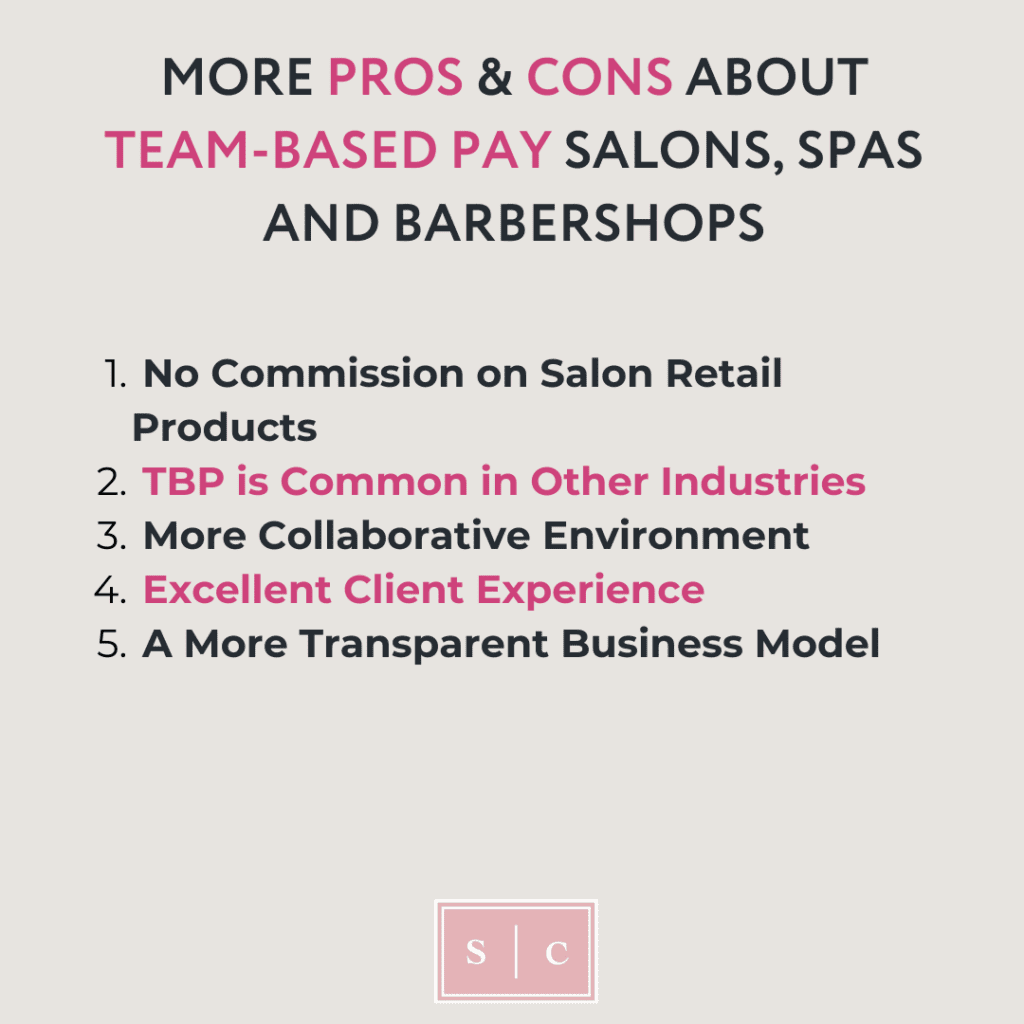I have often heard about but have never worked in a team based salon. Curiosity got the best of me, so I dug deep to not only understand team-based pay in salons but to give you an unbiased, uncompensated take on how it may or may not be a good idea for your career.
Thank you for reading this post, don't forget to subscribe!
If we haven’t met, my name is Susan Wos, I am the owner and founder of Salonspa Connection. Our platform is non-brand affiliated, meaning, we don’t work for hair product companies and are not paid or sponsored to give one sided opinions.
Since I do not have a dog in the “best salon business model” fight, the following information comes to you from an honest POV, designed to help you determine the best path for your career. I will address both what I see for salon owners and for beauty pros in this blog, so feel free to skip to the table of contents to make the best time out of your mini- TBP education, if you don’t need ALL the deets.
I see my fair share of business models in salons, spas and barbershops. My job is to help stylists find salons to work in and to find salon buyers for owners who are ready to pass the torch. I’ve worked with countless owners, consultants, stylists and beauty professionals around the globe, so getting the full picture of how team based pay salons works, (and doesn’t work), for everyone involved, was top on my list to uncover.
I have read everything I can about TBP, and even asked around in some Facebook forums on this subject matter. Join me as I let you in on some of the best parts of this salon model, and discover the not so great stuff for both owners and salon professionals.
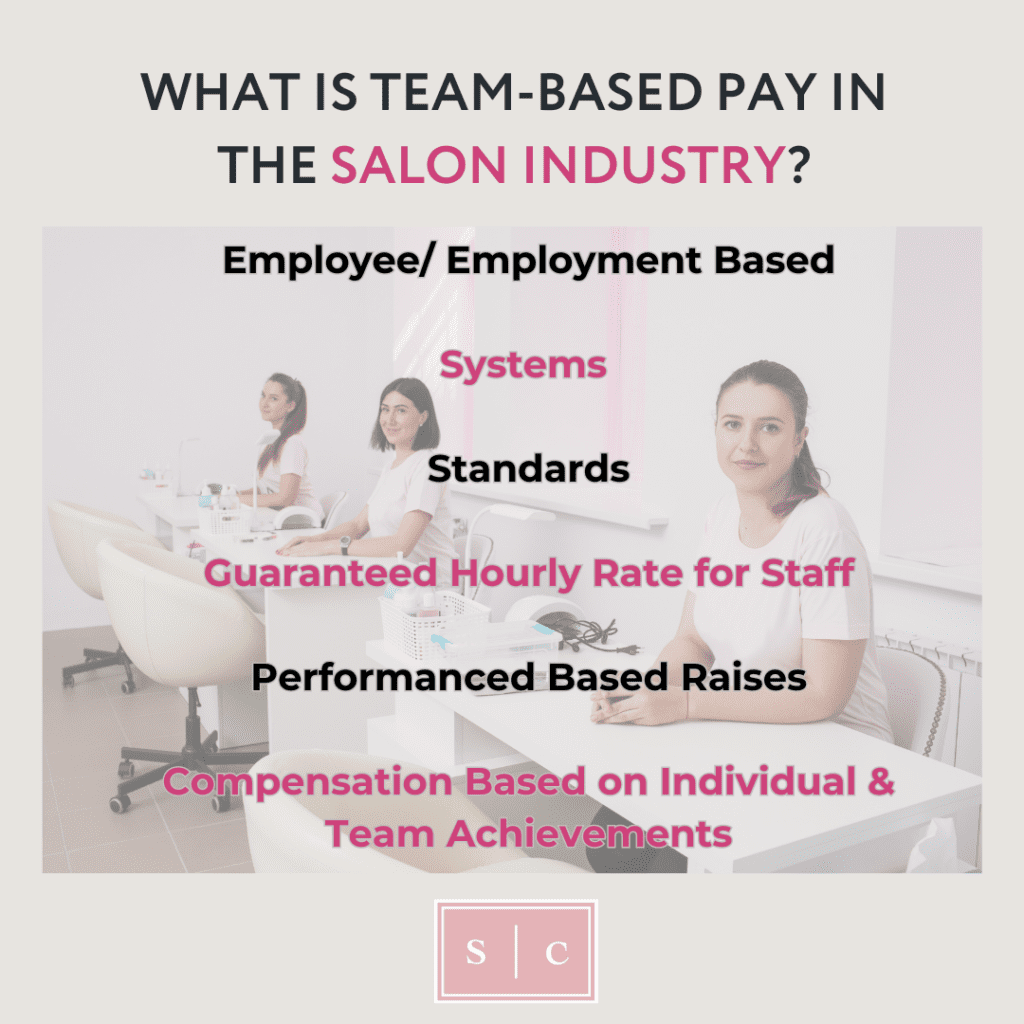
A Team-based beauty business is an employee-based model that provides systems, standards, protocols and methodology to a career in the salon industry. This is achieved by setting a guaranteed hourly rate for employees and offering bonuses based on how well both the individual and the overall company performs.
This means, employees have guaranteed wages but are dependent upon subjective and non-subjective aspects of their own”performance”, and others, in order to increase their wages. Thinking through the team-based salon for what it would be like for owners and stylists, opened up a lot of different ideas I have about employment, and alternative ways to view this less common choice in salon employment.
Neil Ducoff is the founder of Strategies Consulting, and long time associate of product company, Aveda. Team based pay for salons is his “invention” and the basis for Strategies consulting offerings.
Given that Aveda isn’t too keen on the salon suite or booth rental salon model, the team-based business model is geared toward pro-employment and is not for the independent hairstylist crowd.
“Commission and high payrolls have been the salon industry’s elephant in the living room far too long. ” -Neil’s quote from a LinkedIn post that has been removed, but documented in this article.
Neil is decidedly against the straight up hourly compensation model, commission-based salon model and booth rental model, offering the team-based pay salon as the solution to a host of industry issues. Before you buy into any salon philosophies, please understand that unless the leadership in your business is solid and fair, there is no strategy, consultant or idea will save your salon from failure.
Teamwork makes the dream work, but does this work for creatives? Any business would dream of a cohesive and collaborative team, lifting each other up and accomplishing goals to reach the highest earning potential for both themselves, and the company.
Being compensated for overall performance really is a good thing, the problem lies in the judgement of said performance. Outside of service and retail sales or “numbers”, most every other evaluation point for a pay increase is… subjective.
Many stylists, including myself, have been a part of a wonderful and whole team where the management sucked. With poor leaders in place, over time, the salon environment erodes, stylists quit the salon and management stays in place, making everyone’s lives miserable.
In a perfect world, team based businesses are a great idea. The compensation structure works for everyone who is invested in the company’s growth, the model will keep payroll at a manageable rate and everyone wins.
But, this industry is full of creatives, “idea people” and most importantly, individuals who can be independent, very easily.
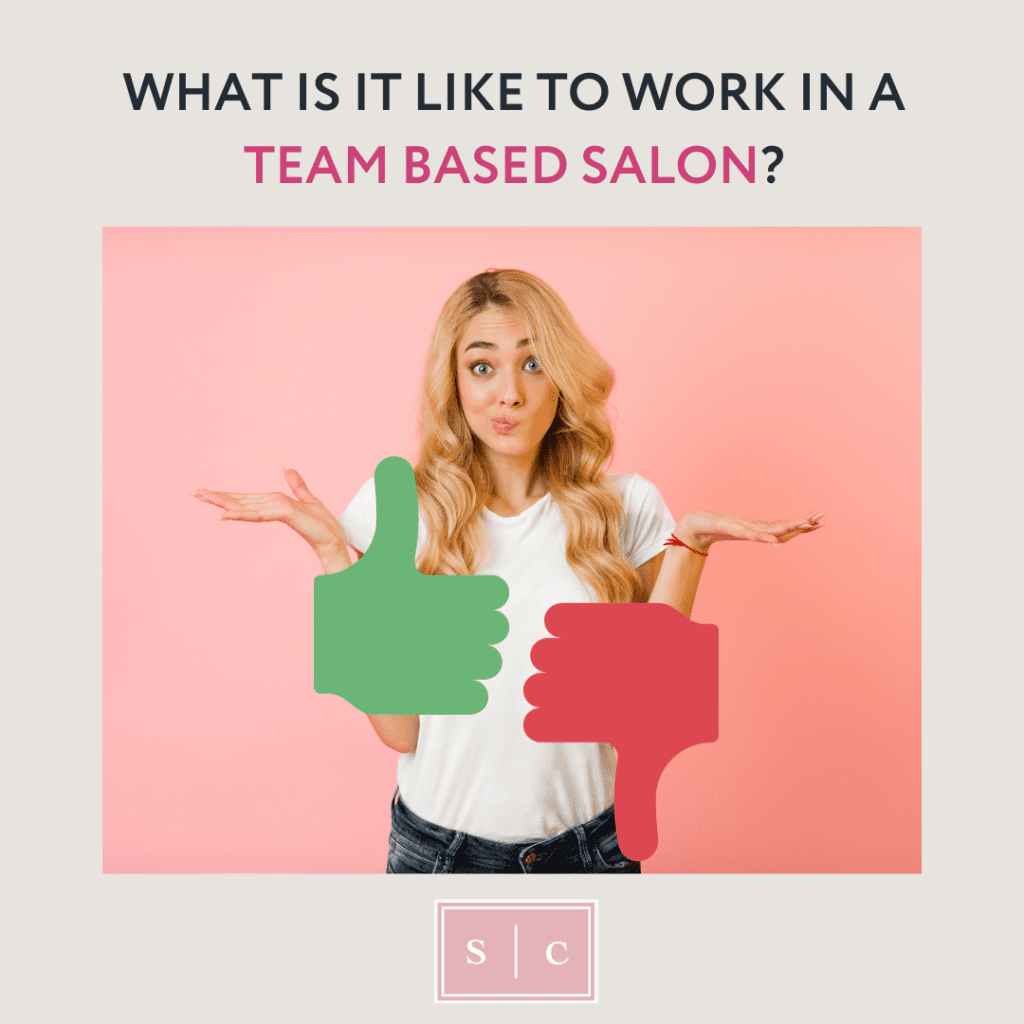
Salons typically operate at a 10% profit margin, if all goes well. Salons can be and are profitable when you know how to manage money, be an effective marketer and pay your staff.
TBP banks on employees buying into incentive pay, less responsibility than booth rental, stability and those who want to feel like they are part of a great company. In exchange for this salon agreement, marketing is provided as well as products, some hair tools and a host of perks for beauty pros who don’t want to be independent and handle it ALL.
While there are definitely beauty professionals who would thrive in this type of environment, our statistics show that this is not the preference of high achieving stylists.
“…raises are based on individual and team performance, not price increases. everyone gets bonuses, not just stylists- Top producing, fully booked, service providers gain most. When fully booked, commission service providers can hit a pay ceiling. (Yes, individual price increases can help, but ceiling still exists.)”. -quoted from Neil’s business, Strategies.
This means when the salon raises prices, the only people who get a raise is the owners. This is all good and fine but I can see where not getting raises and bonuses when the salon makes more, could cause some drama and salon issues amongst an entitled team.
So, what does it look like to earn in a Team-Based Salon?
• You receive a base pay for hours worked, starting with minimum wage. Every employee is given a different hourly wage which fluctuates based on your perceived performance. States like California are beginning to require double the minimum wage, so this varies according to state employment laws.
• Pay is given at a set rate for services performed. Bonuses and incentives are rewarded when expectations are met for individuals and the entire team.
• Upselling services yields additional pay.
• Retail sales yield additional pay.
• You get raises and bonuses based on performance. These can include: leadership skills, attitude, average ticket and retention rates. Rewards are given based on company expectations, how well your co-workers perform and how your performance compares to others.
Compensation is a mixture of tangible key performance indicators, (KPIs), as well as subjective performance standards. This method of compensation is less clear than it is as a commissioned employee, straight hourly wage or salaried position.
To be a successful salon owner in this business model, you must understand your numbers and be very clear about expectations and compensation.
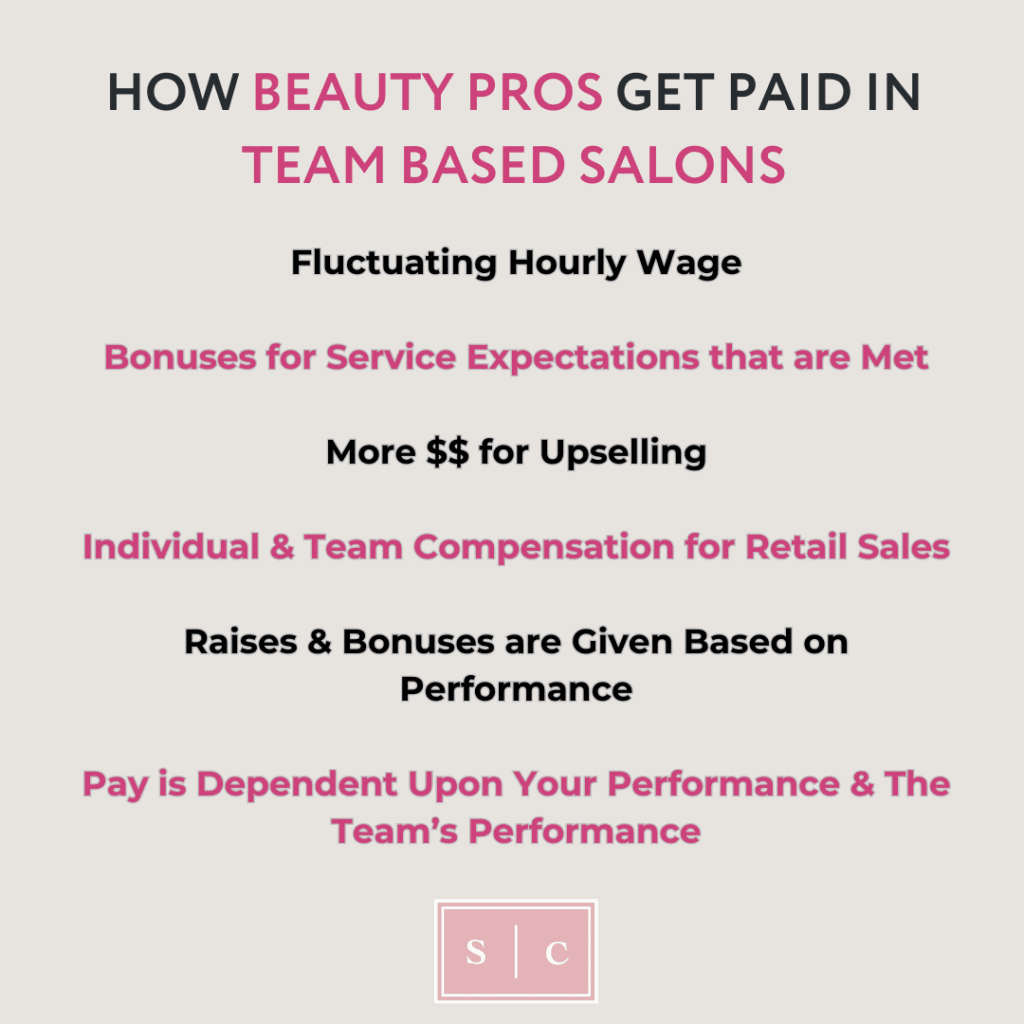
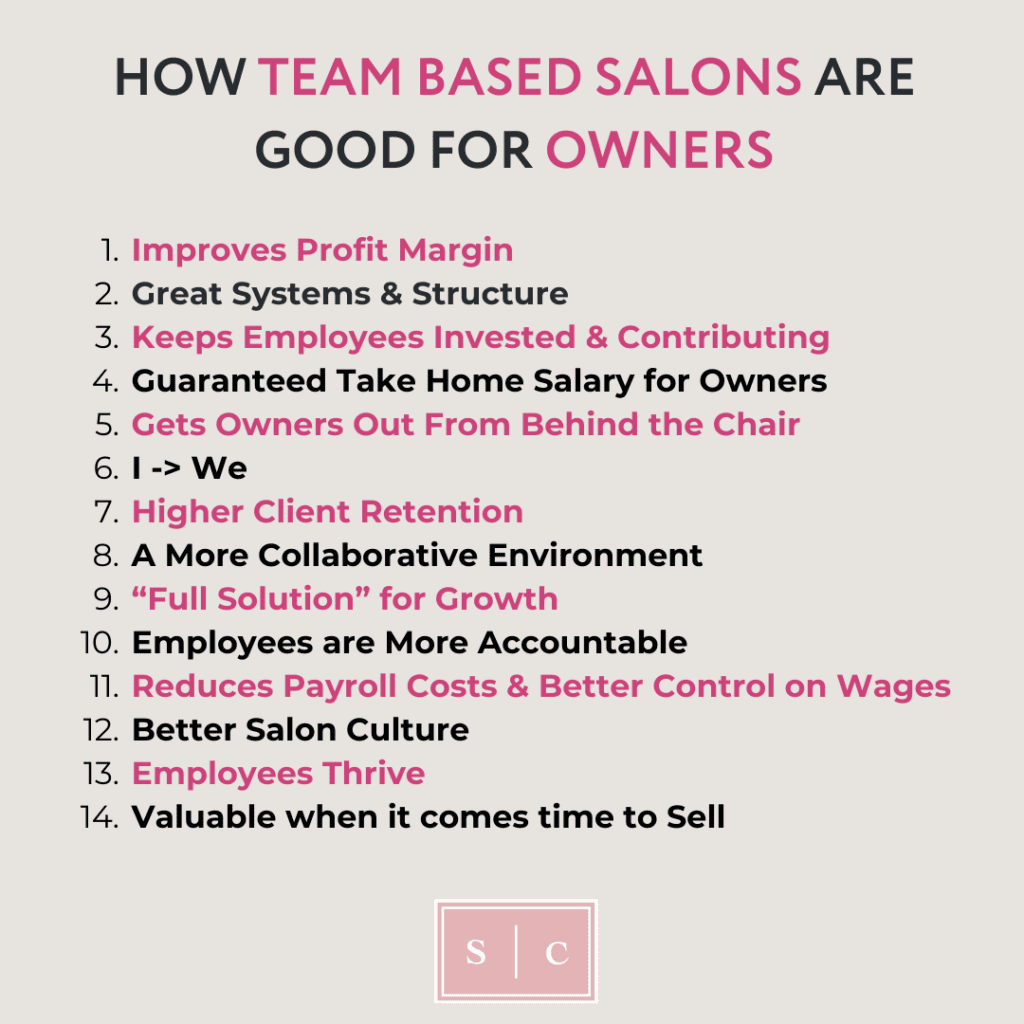
If you have made it this far, congratulations! Taking in all of this information means you are either a nerd like me who loves salon industry research or you are truly invested in finding the right business model for your salon career.
Either way, I hope you have enjoyed my honest take on team based pay in salons! Feel free to reach out should you have any questions or input on this blog on LinkedIn, Instagram or Facebook. I am always happy to hear what our members think, and getting feedback only helps us provide more value to the industry.
Best of luck to you in your career!
Yours in service,
